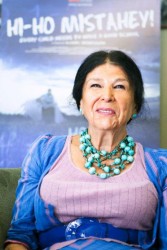Article Origin
Volume
Issue
Year
World-renowned Abenaki filmmaker Alanis Obomsawin has done it again. Hi-Ho Mistahey! is the forty-second documentary she’s made and the film premiered at the 38th annual Toronto International Film Festival (TIFF).
Obomsawin has been with the National Film Board for 45 years and has made 42 films, almost one film a year. Obomsawin, a very young looking 81-year-old with the vibrant energy of someone half her age, the filmmaker shows no sign of slowing down and, in fact, has four projects in the works. Added to this is a book she’s planning about her life and her work.
“There are things that must be done,” she said, “and I can do it.”
The subject of Hi-Ho Mistahey! is First Nations education and the federal government’s refusal to provide the same level of education funding for First Nations children as the funding given for non-Aboriginal children.
The film focuses on the story of Shannen Koostachin, a 13-year-old Cree girl from Attawapiskat First Nation who refused to accept the status quo. She didn’t believe that First Nations children don’t matter and don’t deserve the best.
Shannen and the children of Attawapiskat were being educated in run-down portables, a situation that came about because of a diesel fuel spill on land occupied by the school. For many years, the children and teachers were getting sick from the benzene fumes from the spill and the school was torn down with a promise from Indian Affairs that a new school would be built.
After 10 years with no sign of a new school, Shannen met with the Minister of Indian Affairs and was informed that a new school for her community was not a priority. She took her message that “every child deserved a safe and comfy school” to other schoolchildren across the country, inspiring a movement called Shannen’s Dream, which set about to tell the world about the federal government’s discriminatory policies and practices towards First Nations children.
In 2010, when she was just 15, Shannen Koostachin died in a car accident, a young woman described by her father in the film as, “a very special girl with a special gift to move people with words.”
His daughter, he says, believed in people, believed she could change people. Her friends, family and teachers attest to Shannen’s charisma and mourn the tragedy of her passing.
Obomsawin presents the community of Attawapiskat with all its flaws, triumphs and beauty – teenagers lost to suicide, the social problems, the goose hunt, its history of traditional practices, and the resurgence of tradition with programs for youth in Cree language and traditional singing, drumming and dancing, all of which are taught by volunteers.
On the faces of the people are sadness, pride, joy and hope showing the audience there is more to Attawapiskat and its people than social problems.
There are several scenes with schoolchildren in Ottawa, Gatineau and Toronto schools, the children who have been inspired by Shannen’s Dream and boisterous in their enthusiasm to create change. Through Shannen’s work, they’ve learned how the government’s policies and practices have adversely affected Aboriginal children and their ability to succeed. Thousands of them gather at Parliament Hill for Have a Heart celebrations on Feb. 14 with letters and messages seeking accountability from the Prime Minister. It’s clear these young children understand the nature of discrimination and they find the government’s treatment of their First Nations counterparts unacceptable.
The film follows the Aboriginal youth delegation to the United Nations Committee on the Rights of the Child. They meet with the Committee behind closed doors. The young people are optimistic that their message has been heard.
We are presented with some startling facts by Charlie Angus, NDP Member of Parliament for Timmins whose riding includes Attawapiskat. The funds for First Nations education held by federal Aboriginal Affairs is not protected and is often diverted to pay for lawyers and lawsuits and “spin doctors.” In the last five years, $122 million that should have gone to building First Nations schools has been siphoned off for these purposes. There is an annual shortfall of $189 million in capital funding for First Nations schools.
Obomsawin is optimistic that change will occur because of the young people today. Speaking at the First Peoples Cinema Press Conference hosted by TIFF on Sept. 6, she said, “Where we’re going is very different from where we’ve been.” There is a movement going on, she said, where “young people talk like old people. They’ve been through hell and back… the darkness is going away and, for some, it’s gone.”
- 4219 views

